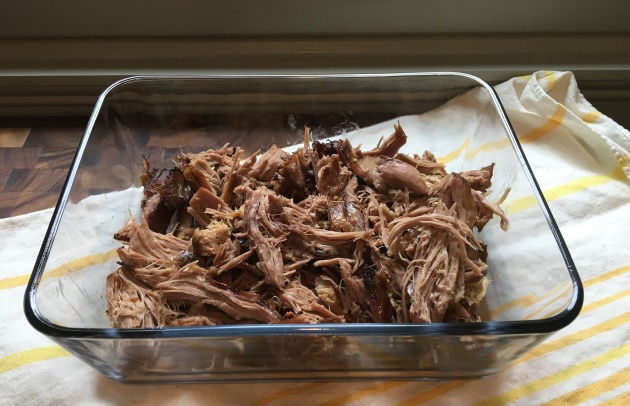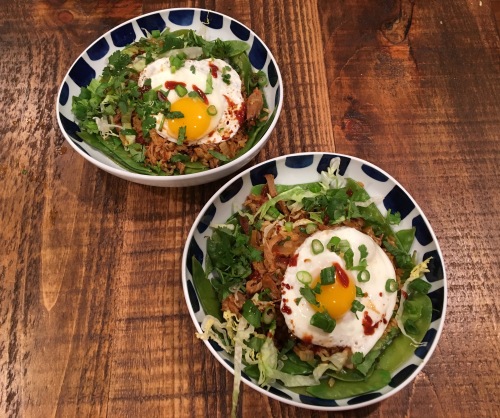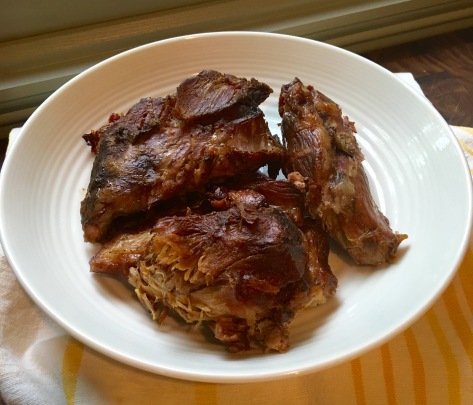 Sitting at my desk early on a rainy Friday, I checked emails between recipe searches, looking for a no-fuss weekend project that I could cook while doing the fifteen things I had already planned to do. Inspired by my mother, who made pulled pork in the oven last weekend, and my friend Laura, who posted on Facebook that she had made Kalua pork tacos, I had pig on the brain, and I focused my Googling efforts on pork shoulder.
Sitting at my desk early on a rainy Friday, I checked emails between recipe searches, looking for a no-fuss weekend project that I could cook while doing the fifteen things I had already planned to do. Inspired by my mother, who made pulled pork in the oven last weekend, and my friend Laura, who posted on Facebook that she had made Kalua pork tacos, I had pig on the brain, and I focused my Googling efforts on pork shoulder.
Remember how I said I was looking for no-fuss? Well, I found it on SkinnyTaste: a three ingredient recipe for pulled pork that cooked in fourteen hours with almost no human intervention. How was this possible? It was a recipe for Crock Pot Kalua Pork.
I will admit that although I’m not gaga over slow cookers the way many of my more culinary-inclined friends are, I own two of them (a large one to cook for crowds, and a small one when I’m just cooking for me & Paul). Yes, they’re great for chilis and soups and injecting life and flavor into dried beans, and once I made perfect poached chicken in the slow cooker, but otherwise I don’t consider it the life-changing appliance many people do.
Well—I didn’t. And then I made pulled pork in my slow cooker.
I’ve got a recipe and instructions below, but what I need to tell you guys is that this is the perfect recipe to prepare when you have a hundred million things to do and have no time to cook. A slow-cooking pork shoulder fills your house with this wonderful smoky, baconesque aroma, and if you turn on the crock pot before bedtime, you will wake up the next morning to PORK. (Seriously, Saturday morning was like waking up in Jenny’s House of Bacon. Amazing.) And a pork shoulder (AKA pork butt) is a big piece of meat, so you can make it last meal after meal using it all kinds of ways:
- tacos
- on Sandwiches with pickles and cole slaw and sriacha mayo
- with rice & beans
- in a hash with eggs and toast
- in lettuce wraps with Hoisin sauce & veggies
Or you could do what I did for dinner tonight, and make Pulled Pork & Kimchi Fried Rice. FANTASTIC. I followed all the instructions in this recipe & substituted the pulled pork for the spam (because, uh – pulled pork rates better than spam any day).

RECIPE:
No-Fuss Slow Cooker Pulled Pork
Adapted from Skinny Taste

Time: 14.5 hours, largely unattended
Special Equipment: 4-quart programmable slow cooker (crock pot)
Ingredients:
- 1 boneless pork shoulder, 2 – 3 pounds
- 2 tbsp coarse sea salt (red Hawaiian salt is great if you can find it)
- 1.5 tbsp liquid hickory smoke (such as Stubb’s)
Note: start the cooking the night before you want to serve the pork.
Method:
Unwrap the pork shoulder and trim of excess fat (the chunks and so forth, not the marbling). Sprinkle the salt on the meat and press it into the flesh. Put the pork in the slow cooker, and pour the liquid smoke on top.
Place the lid on the slow cooker and program it for 8 or 10 hours on Low (mine has a 10-hour option). Then, go put on your pajamas and go to bed.
Wake up the next morning and inhale the aromas. Then check on the pork. It’s going to look brownish gray and sitting in a pool of its own fat and juices. This is actually what you want. When the timer goes off, remove the pork from the slow cooker carefully and set it aside in a dish. Then pour out the fat & juice mixture.
Return the pork to the slow cooker, drizzle two spoonfuls of the juice on top of the pork and cover again. Set to cook on low for 4 hours.
In the meantime, let the juice cool and then refrigerate. The fat will float to the top and congeal, and then you can spoon it off easily. Save the juice to make sauce, or just to keep the pork moist.
When the timer goes off the second time, remove the pork from the slow cooker and allow to cool for about a half hour. Then, using two forks, shred the meat. Once its completely cooled store in a glass container in the fridge for up to 4 days, if it lasts that long. When you’re ready to use it, reheat gently on low using some of the leftover juice.
Serves: 4 – 6




